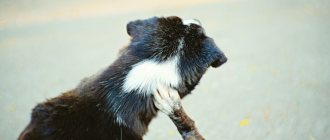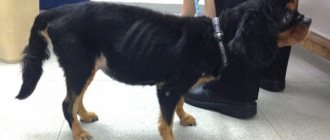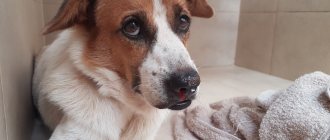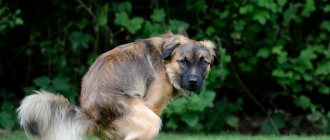Lice eaters are found in the thickness of the fur, feeding on scales of fallen epidermis and hair. The eggs are attached to the base of the fur with a sticky substance that cannot be washed off with water. Another name for the parasite is Trichoderma. Insects crawl, gnaw the skin, cause itching, and the dog begins to itch. The wool loses its metallic shine and falls out. Scratching becomes contaminated with microflora, and dermatitis develops.
Inside the lice eater is the larval stage of the cestode Dipylidium caninum. When the dog ingests the parasite, it becomes infected and a tapeworm, the cucumber tapeworm, develops in the intestines. Its mature segments are shaped like cucumber seeds. If a person pets a dog and accidentally swallows a lice eater, he may become ill with dipilidia. Human skin is not suitable for lice eaters.
Infection process and symptoms
There is only one way of infection by lice eater - through direct contact:
- Contact with an infectious animal. Most often, when interacting with stray animals, pets become infected with lice and fleas.
- Even if we exclude any interaction between a domestic dog and any stray animals, there is still a risk of infection. Lice eaters are too small to be seen with the naked eye, and a dog owner may unknowingly carry the parasite on their hands, shoes or clothing.
- From mother to puppy, with direct contact.
If an animal is infected, but there are still few parasites and they are not active enough, it is very difficult to detect them. But when lice eaters multiply, the disease can be identified by the following symptoms:
- The dog experiences severe itching, which is why it scratches constantly.
- The presence of light flakes in the dog's fur, similar to dandruff. Lice eaters are sedentary parasites, but upon very careful examination you can see how these “flakes” move.
- The dog's fur becomes dull, brittle, becomes matted and sticks together.
- Partial baldness may occur - the inner thighs and base of the tail are especially susceptible to this.
- When there are a lot of parasites and they cause severe discomfort to the pet, the dog may lose its appetite, become apathetic, and lose weight.
We recommend reading the article: “Fleas on dogs: how to get rid of parasites, a review of the best remedies.”
Routes of infection
Experts agree that even healthy and well-groomed dogs can become infected with lice. This happens especially often in autumn and winter. Lick eaters pose a great threat to puppies, since their immunity is not yet strong enough to cope with the parasites.
Veterinarians have listed the ways in which the lice beetle is transmitted from one pet to another.
These include:
- contact of a pet with a sick animal;
- increased air humidity in the pet’s habitat;
- rare hygiene procedures;
- poor diet, lack of vitamins and microelements;
- Puppies can get hairworm from their mother.
Appearance of the parasite (photo)
The lice beetle belongs to the order of lice and lice. This is a very small insect with a flat body. The length of the parasite is about 1 mm, the color ranges from grayish, transparent to yellow. On the skin of an animal, the lice eater looks more like particles of dandruff than a parasite.
The body of the lice eater looks very much like a louse or a flea, but there is one distinctive feature - the shape of the head. In the lice eater it is wide, wider than the body. The parasite feeds not only on blood and lymph, but also on particles of skin and fur.
The lice beetle reproduces very quickly. The female lays about 70 eggs during her life cycle, which are attached to the animal’s fur using a sticky liquid. After about a week, larvae emerge from the eggs, which only a month later become adults, having previously gone through three stages of molting.
Danger to your pet
The ectoparasite, which is the lice eater, not only brings discomfort to the animal, but can also be a carrier of helminths and be a catalyst for the development of other unpleasant and dangerous diseases.
If there are lice eaters on the dog’s body, there is a very high probability of developing trichodecosis.
Lice eaters cause severe itching in the dog and, by furiously combing and biting the fur, the pet injures itself, and open wounds appear that can become infected.
The presence of parasites in general greatly weakens the dog’s body, immunity decreases, and chronic diseases or allergic reactions can worsen. Due to a decrease in the body's protective functions, the dog is susceptible to various viral or infectious diseases.
Signs of lice in dogs
How can you tell if your dog is infected with a dangerous lice-eating parasite?
There are several signs of infection:
- the animal feels itching on the body and because of this itches constantly;
- “dandruff” falls off the dog; you can also see it by parting the hair;
- the animal may begin to lose weight;
- you can notice wounds on the body caused by scratching;
- at the base the wool is white, as if with a coating;
- the dog’s behavior becomes agitated, the character becomes irritable;
- outwardly it becomes clear that the dog is worried about something.
Treatment
Despite the frightening symptoms of the disease, lice eaters are destroyed quite simply. The main thing is to start treatment as early as possible, without leading to concomitant diseases or the development of infection. Drops, shampoos, sprays or insecticidal collars will help get rid of the parasite.
Drops
The most common remedy for getting rid of fleas and lice are drops. Today, the market offers a huge variety of different drugs to combat parasites - both industrial, with the addition of various chemical compounds, and based on natural oils or decoctions.
- Based on various chemicals. They consist of a combination of various substances with an insecticidal effect.
- Based on pyrethroids (the active substances are permethrin, (ci)phenothrin, flumethrin), the most common products in the form of drops are UltraGuard (from 800 to 1200 rubles per pipette, depending on the weight of the dog); Bars drops (from 115 to 300 rubles depending on weight); beaphar (from 170 rubles per pipette).
- Based on phenylpyrazoles (active ingredients fipronil, pyriprole): Frontline drops (from 580 to 800 rubles per pipette); Bars Forte drops (from 150 to 300 rubles); Dana ultra drops (from 100 to 200 rubles); Outpost (330-470 rubles for 1 pipette);
- Based on diazinon: Celandine (from 70 rubles).
- Based on essential oils. Many products consist not only of natural ingredients, but also contain chemicals: Green Fort (from 150 rubles per pipette).
The drops must be applied strictly according to the instructions and in those places that the dog cannot lick - if ingested, the drops will lead to poisoning. It is advisable to carry out the treatment using disposable gloves. To apply the drops, you need to part the dog's fur at the base of the skull, apply a small amount from a pipette to the skin (not on the surface of the fur, but on the skin) and move further along the spine. The number of drops and application points depends on the size of the dog - the larger the dog, the greater the number of drop points you can “put” on it.
Many drops have contraindications and possible manifestations of allergic reactions. In addition, you need to carefully read the instructions before buying a product for a puppy - many substances are prohibited from being applied to the skin of pets before one month of age.
Shampoos
Shampoos are effective for initial treatment - they will help remove adult individuals from the fur. But they won’t be able to cope with the eggs; they stick very tightly to the hairs.
Any shampoo with an insecticidal effect is suitable for treating an animal: for example, Bars shampoo (costs 170 rubles) or Lugovoy (about 170 rubles).
Puppies can also be treated with insecticidal shampoos. Unlike other products, shampoos cause fewer allergic reactions in animals.
Sprays
Treatment sprays operate on the same principle as drops, only they are applied not to the animal’s skin, but directly to the fur . The treatment of the animal should be carried out in a well-ventilated area or outdoors, after wearing disposable gloves and a face mask - chemicals should not get into the lungs.
After treating the dog, you need to hold it, waiting until the substances are absorbed into the fur and the dog dries. Until the product is completely absorbed, the dog should not be allowed to lick.
Sprays can also be either chemical-based or essential oil-based. The active ingredients of the spray are the same as in the drops - only the packaging and method of application are different.
Bolfo spray (costs about 500 rubles) has proven itself well in the fight against fleas, lice and ticks (including ixodid ticks).
Before you start applying the product, you need to read the instructions - often, in an attempt to save on drops, dog owners incorrectly spray the product onto the coat: it should be completely moistened with the product. So for a large dog it can take a whole pack at a time.
Collar
A collar that protects against fleas, ticks and lice is a rubber strap with a clasp . It is impregnated with chemicals that repel parasites.
The active ingredients in collars are the same as in drops and sprays. But if the sprays do not last long, until the dog’s first bath, and the drops protect for no more than a month (on average), then the collar repels insects for much longer - from 3 to 8 months.
The choice of collars is even more varied than drops. Their cost is slightly higher. A leopard or Beafar will cost about 200 rubles, a Foresto collar will cost 2,000 rubles.
In addition to protecting against fleas and lice-eaters, collars do a good job against ticks (but the validity period of an acaricidal additive is much shorter than that of an additive protecting against lice-eaters).
For the collar to work well and for a long time, you need to wear it correctly:
- It should not be tightened very tightly so as not to strangle the dog or cause skin irritation;
- It should not dangle loosely.
- It is optimal that you can freely put your fingers under the collar: in this case, the ammunition will protect the pet from parasites and will not cause discomfort when worn.
Like any chemical, impregnation of the collar can cause an allergic reaction. Therefore, if the dog develops itching or redness of the skin, or hair falls out at the site of the strap, then you need to immediately remove it and rinse the trace of the collar well several times to wash off all the chemical components.
Preparations for lice
Treatment of lice in dogs is carried out after consultation with a specialist. This will avoid mistakes that can lead to aggravation of symptoms. When the doctor prescribes a remedy for lice to the animal, therapy can be continued at home, in a more familiar environment for the dog.
There are a lot of antiparasitic drugs. This can be a spray, drops, special shampoos and collars. Let's discuss each of the means in more detail.
Drops
The drops from lice beetles contain an insecticidal component that fights ectoparasites. A distinctive property of the drops is that they not only eliminate parasites that have already settled on the dog’s skin, but also protect against the risk of re-infection for six months.
The drug must be applied to the withers or spine area so that the pet cannot lick it off.
Veterinarians recommend drops from brands such as Irbis and Bars. Please note that these products are potent and contain active chemical elements, so strictly follow the instructions when using.
Sprays
The aerosols contain the same antiparasitic component found in the drops. However, they are easier to apply to large surfaces. The therapeutic effect lasts for three weeks.
To enhance the effect, reapply the spray every week. Put a protective collar on your dog to prevent him from licking the product from his fur. Sprays from such brands as “Defendog” and “Blokhnet” have proven themselves well.
Shampoos
A universal remedy that is suitable even for puppies who have received skin beetles from their mother. Pediculicidal shampoos have a mild moisturizing effect, soothe itching and improve the appearance of your pet's coat.
They do not cause allergies and smell pleasant. With their help, you can easily get rid of not only lice eaters, but also ticks or fleas. Suitable for dogs of all breeds and ages. Veterinarians recommend shampoos such as “Lugovoi” and “Fitoelita”.
Pills
Chewable tablets against parasites are convenient to use. They have a pleasant taste, so the pet eats the medicine without resistance. There is no danger that the animal will lick the drug; it does not need to be restricted from contact with children during treatment.
You can, as usual, pet your pet, bathe her, and play with her. Tablets can be given with food or separately. One tablet usually lasts for three months. Dog owners choose Nexgard and Bravecto.
Other means
In addition to those described above, there are also other types of products that protect against fleas, ticks and lice - key chains and tablets.
- key fob works by transmitting signals in the ultrasonic range and repelling both blood-sucking insects and ticks. The cost of such a product ranges from 1,500 rubles to 5,000. Manufacturers of such devices assure that the key fob is valid for 2 years.
- In addition to key chains, there is another product that has an insectoacaricidal effect - chewable tablets . The validity period of such tablets is from one (Frontline Nesgard) to three months (Bravecto). The cost of the product is quite high - from 800 to 1500 rubles per Frontine tablet and from 1300 to 1800 rubles per Bravecto tablet.
The tablet is a wet treat that is soaked in the active ingredient. After the dog eats it, the ingredients penetrate through the gastrointestinal tract into the blood and remain there for the entire duration of action.
The advantage of this remedy is that any blood-sucking insect or tick will definitely die if bitten. A significant disadvantage is that if the substance enters the animal’s blood, it cannot be removed until the entire period of action has expired. The only way is a complete blood transfusion.
Tablets should be used with extreme caution for miniature dogs or animals prone to allergic reactions.
Prevention of the disease
Prevention of lice eaters is:
- Pet hygiene means regular washing and combing of the coat.
- Minimizing the dog's contact with stray animals.
- Timely treatment of your pet against parasites, using any of the means of protection - drops, collars or sprays.
No product gives a 100% guarantee and will protect your pet from all misfortunes. For more complete protection and peace of mind for the owner, products can be combined using different active ingredients in different forms - for example, a collar and drops or a collar and spray.
Causes of lice eaters
As we have already found out, symptoms of the presence of ectoparasites can be direct or indirect. If the dog itches all the time and cannot sit quietly for a minute, it is obvious that he is overcome by fleas or ticks. Bald spots began to appear on the fur - we are dealing with lice eaters.
Indirect signs of the presence of a problem may include pain, lethargy, lack of appetite and other deviations in the pet’s behavior. Pets usually become infected from their domesticated relatives. The appearance of ectoparasites is also facilitated by:
- Poor living conditions. Dirt and dampness in the booth, for example.
- Poor nutrition, lack of protein, vitamins. An exhausted animal has a weakened immune system and does not have the strength to fight the infection.
- Insufficient care. If the dog is rarely washed, antiparasitic prevention and medical examinations are not carried out, it will very soon acquire ticks.
- Close proximity to an infected animal. Puppies are 100% likely to be sick if their mother has lice eaters.
Are lice eaters dangerous for humans?
Despite the fact that lice eaters feed on blood, they do not pose any danger to humans. Parasites that live on a dog’s body are not transmitted even to cats and vice versa.
To maintain vital functions, the lice eater needs a blood and body temperature higher than human.
Lice eaters are very unpleasant inhabitants of dog fur. But with proper hygiene and attention to your pet, such an unpleasant disease can be avoided. To have peace of mind for your pet, you need to regularly prevent the disease.
5 / 5 ( 1 voice )
What does a lice eater look like?
You can determine that you have found a lice eater in a dog by the following signs:
- The body of the parasite is flattened and flat.
- The size reaches 1-2 mm, there are no wings.
- The body is yellowish or colorless, so it is difficult to notice.
- The insect's head is large, out of proportion to the body, and quadrangular in shape.
Dog owners should know that lice eaters love warmth. If an animal is placed next to a radiator or other heating device, then within 5-10 minutes the parasites will crawl out onto the ends of the hairs.











